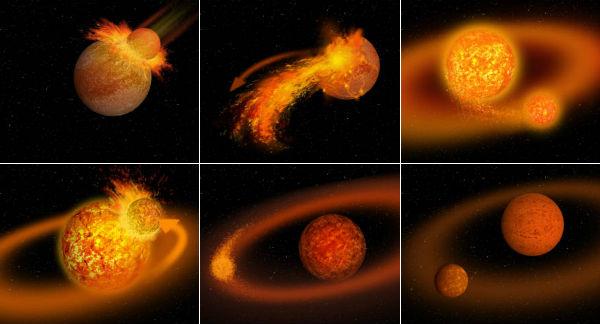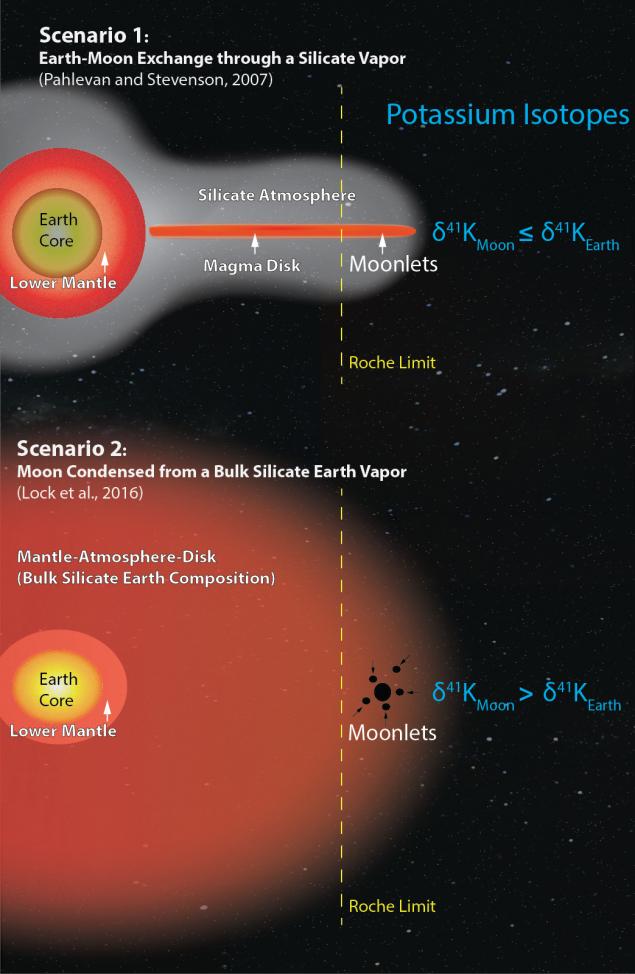Flesh: the Moon probably formed from the primary mantle of the ancient Land
 Bashny.Net
Bashny.Net

The origin of the moon long remained a mystery. Various scientists have put forward the unusual hypothesis. Over time from the variety of proposed variants only a few. The basic variant is the hypothesis that the Moon formed as a result of an ancient collision of the Earth with a giant object that is equal in size to Mars.
There are two basic scenarios of "shock" formation of the moon. In the first case it is assumed that the moon formed from the fragments of ancient Earth and the object that collided with it. Supporters of the second option argue that the mantle protozilla just disappeared in the collision. The particles of the mantle is caught in surrounding our planet space. This material and began to form the satellite in the process of condensation of the vaporized substance.
In order to obtain evidence in favor of one or another scenario, scientists need to compare the number of isotopes in the crust of the moon and the Earth. This analysis had to be very precise. Just last year, scientists from the University of Washington and Harvard were able to develop a reliable methodology to compare the isotopes of potassium. The accuracy of this method in 10 exceeded the capacity of any existing analysis methods.
Using their technique, scientists have found evidence of the validity of the second variant of formation of the moon. According to experts, Earth's collision with another object, it was extremely powerful. In fact, the robe of ancient Earth just disappeared at the time of impact.
The theory of impact formation of the moon
"Shock" theory of the formation of the moon was proposed by the two groups of astrophysicists in the 70-ies of the last century. Scientists suggested that the Moon formed during the collision of Earth with an object the size of which was roughly the size of Mars. After this object is destroyed. From the Ground, too, broke off large pieces. From this material after millions of years and formed our natural satellite. Hypothesis graciously accepted, and since it was considered basic.
In 2001, another group of scientists, conducting isotope analysis of samples of terrestrial and lunar rocks found that in samples contains an equal number of the three stable isotopes of oxygen.

But it was strange, as if the Moon formed predominantly from the fragments of a foreign object smashing into the Earth, of oxygen isotopes in terrestrial and lunar rocks should be a different number. The probability that the number of oxygen isotopes from the Earth and the ancient "guest" may be equal, vanishingly small. It is much less likely than identical fingerprints from two different people.
The issue even got its own name — "isotope crisis". Some time later, the specialists decided to conduct a re-analysis using a more accurate method of determining the amount of oxygen isotopes in rocks of the Earth and moon. The result was the same. "This is the most accurate measurement that we can spend, and they showed the identity of [the number of isotopes in the rocks of the earth and the moon — approx. ed.] — said the scientists who conducted the analysis.
"Isotope crisis" has become even more complex problem than previously. Option errors the analysis excluded measurements was tested more than once.
After that, the scientists came to the conclusion that we need to change some elements of the hypothesis of impact origin of the moon for the updated hypothesis explained all the cash factual material. There are several new hypotheses. One of them is supposed to complete the evaporation of "guest" and almost all of the magma of ancient Earth. Products vapors trapped in the surrounding space and become part of the emerging Earth satellite. The evaporated mantle and the material is a "guest" together upon impact, creating a supercritical fluid, which is also called supercritical fluid. A state of matter in which we lost the distinction between liquid and gas phases. Any substance being at a temperature and pressure above the critical point is the supercritical fluid.
A cloud of red-hot silicate first 500 times the size of modern the moon, followed by condensation. Only born the Moon was a molten ball which gradually cooled.
A video that explains the appearance of the moon from the point of view of a collision with a large object. This visualization of the impact hypothesis of the formation of our satellite, with a low energy collision without evaporation of the mantle:
Potassium is the main argument
A group of American geochemists decided to test the hypothesis, comparing the content of isotopes in the lunar and terrestrial rock samples. As it turned out, in lunar rocks more heavy isotope of potassium (potassium-41) than in the earth. According to experts, such situation is possible if the Moon were formed at a pressure that is ten times higher than the atmospheric pressure on Earth (modern Earth). And this, according to the Americans, is indirect proof of the correctness of the supporters of the second variant of formation of our satellite. There is another indirect confirmation here, too, was tested isotopes, but not potassium, and zinc.
As you can see, the stones can also speak. Only need to be able to adjust with them dialogue and to properly evaluate the answers.
Other hypotheses:
In addition to the hypothesis of the "big blow" has other:
- The hypothesis of centrifugal separation: the authors of this hypothesis argue that protozilla revolved very quickly, so quickly that under the influence of centrifugal forces it is separated from the part from which the Moon formed;
- Capture hypothesis: it assumes that Earth and Moon were formed in different regions of the Solar system. But the Moon, passing the Earth, was captured by the gravitational field of the latter;
- The hypothesis of joint education: the Moon and Earth were formed simultaneously, next to each other;
- The evaporation hypothesis: this hypothesis stated above, it seems that now it has become the primary;
- The hypothesis many moons: orbiting the Earth were a few smaller objects from which formed the modern Moon.
Source: geektimes.ru/post/280388/
Tags
See also
What to do to sleep only a few hours a day at a convenient time
Where went goldfish?
Hiroshima.
MiGs. Famous and not so
Technology interstellar travel in science fiction
7 biggest unsolved mysteries of science.
How to choose a university?
How does the thought of a man
Hidden memory — body memory
From where comes our knowledge
















